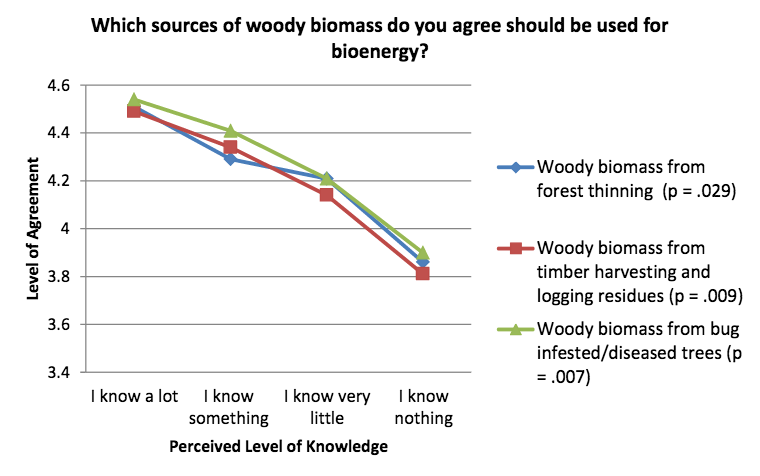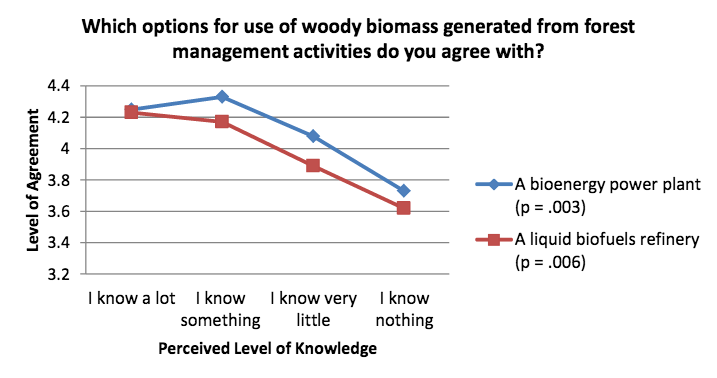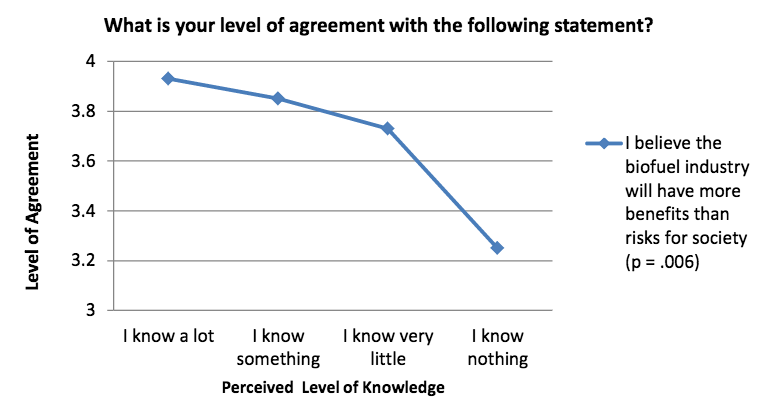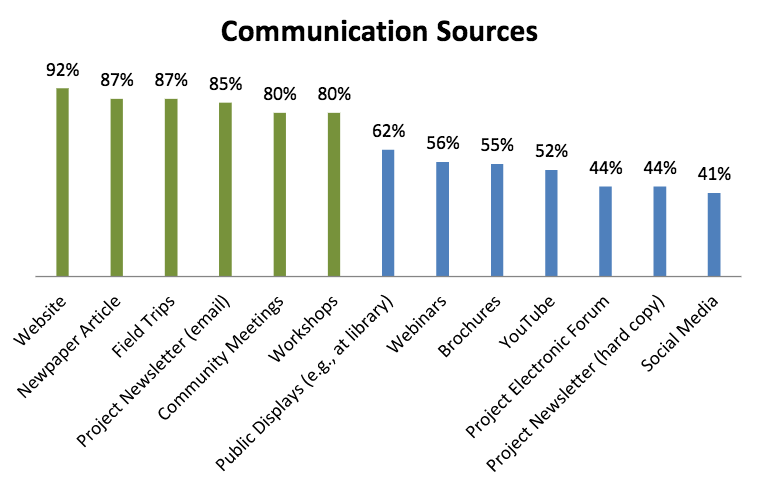 |
October 2016
|
October 2016 // Volume 54 // Number 5 // Research In Brief // v54-5rb10
Slash and Learn: Revealing Stakeholder Knowledge, Support, and Preferred Communication Methods Relative to Wood-Based Biofuels Projects
Abstract
The Northwest Advanced Renewables Alliance (NARA) is examining the feasibility of a woody biomass-to-biofuels supply chain in Idaho, Montana, Oregon, and Washington. A part of the ongoing feasibility study involved conducting a survey of informed stakeholders on the use of woody biomass from forest residuals in producing sustainable bioenergy. Survey findings indicated that the more knowledgeable stakeholders considered themselves, the more supportive of biofuel-related activities they were. Also, survey respondents generally wanted to be able to obtain information on the topic on their own and at their own convenience, such as by accessing a website, and through face-to-face forums, where they could ask questions.
Introduction
The Northwest Advanced Renewables Alliance (NARA) is a collaboration of universities, government, and industry supported by a $40 million U.S. Department of Agriculture (USDA) grant awarded to Washington State University in 2011. NARA is examining the environmental, economic, and social feasibility of a regional system for sustainable production of biofuels and bio-based products from woody biomass—specifically, softwood postharvest forest residuals and construction and demolition waste—in Idaho, Montana, Oregon, and Washington.
In 2013, NARA completed a survey of stakeholders in the four-state region. The three goals were
- to better understand stakeholder perceptions regarding the use of woody biomass from forest residuals in producing sustainable bioenergy—in particular, liquid jet biofuel;
- to assist the NARA outreach and education teams in better targeting their materials and information; and
- to determine levels of social acceptance and support related to the identification of potential communities in which to locate facilities for conducting activities in the biomass-to-biofuels supply chain (e.g., depots where biomass is sorted and chipped, conversion facilities where wood chips are converted to isobutanol, and refining facilities) based on an analysis of natural and physical assets by various NARA teams.
There has been limited research assessing the knowledge, perceptions, and opinions of stakeholders regarding the use of woody biomass as a source for aviation biofuels and the effects these factors have on the social acceptability of a biofuels supply chain (Moroney, 2015). This is a critical area of study because lack of support and negative perceptions have been cited as the main obstacles that can hinder the success of a biofuels operation (Rösch & Kaltschmitt, 1999; Walker, 1995). Important steps in gaining support for the emerging wood-to-biofuels industry include identifying knowledge gaps and finding ways to communicate information to diverse stakeholder groups (Mayfield, Foster, Smith, Gan, & Fox, 2007; Peelle, 2001; Upreti & van der Horst, 2004).
The mixed-methods survey conducted by NARA in 2013 involved questions related to stakeholders' knowledge about, perceptions of, and levels of support for a wood-to-biofuels industry. It also addressed stakeholders' preferences related to methods for receiving information about biofuels projects (i.e., communication sources from which to receive information). Although the survey covered a variety of topics, this article focuses on survey results pertaining to stakeholders' knowledge levels, levels of support, and preferred communication sources.
Methodology
Prior research studies addressing topics related to biomass, bioenergy, and biofuels were used to guide development of the NARA survey instrument (Adams, Hammond, McManus, & Mezzullo, 2011; Becker & McCaffrey, 2011; Clement & Cheng, 2011; Davenport, Leahy, Anderson, & Jakes, 2007; Halder, 2011; Halder, Pietarinen, Havu-Nuutinen, & Pelkonen, 2010; Mayfield et al., 2007; Monroe & Oxarart, 2011; Nelson, 2005; Plate, Monroe, & Oxarart, 2010; Stidham & Simon-Brown, 2011; Upham, Shackley, & Waterman, 2007). The studies included a variety of quantitative and qualitative measures, such as multiple-choice and scaled-response questions in addition to open-ended, less-structured questions. The final NARA survey consisted of 22 quantitative and qualitative questions addressing topics that included
- perceived knowledge,
- worry,
- perceived benefits/drawbacks,
- agreement,
- trust,
- support,
- communication methods, and
- demographics.
To increase response rates, a mixed-mode survey design was used, with participants having the option of completing the survey instrument online, answering the questions over the phone, or returning the completed survey instrument by mail (Dillman, Smyth, & Christian, 2014). Initial email invitations with a link for taking the survey online were followed by a reminder email 1 week later, a phone call 2 weeks after the email reminder, and, finally, a hard copy in the mail 1 month to 6 weeks after the initial email invitation. Emails were sent to government officials at local, state, and federal levels; individuals working or otherwise involved in the wood products industry; natural resource managers in tribal communities; and individuals with environmental conservation interests, such as those involved with environmental nongovernmental organizations and conservation groups. All types of stakeholders were contacted in each of the four states (Idaho, Montana, Oregon, and Washington). Hard copies of the survey were mailed to all contacts who did not complete the survey online or over the phone.
Participants were asked to rate their level of knowledge about the use of woody biomass to produce liquid biofuels on a scale ranging from 1 (I know a lot) to 4 (I know nothing). They also were asked to rate their level of agreement with various statements about biofuels-related topics on a scale ranging from 1 (strongly disagree) to 5 (strongly agree). In addition, participants were presented with a list of 13 communication methods that could be used to increase community awareness about a biofuels project and asked to select those they would prefer to use to receive such information (all that applied).
Results and Discussion
The survey was sent to 868 stakeholders; 345 completed it, resulting in a 40% response rate. Of those who completed it, 70% did so online, 26% completed hard copies, and 4% took the survey over the phone.
Consistent with other studies, findings from the NARA survey indicate that respondents' self-reported levels of knowledge influence their levels of support for the biofuels industry, when compared using regression (Monroe & Oxarart, 2011; Qu et al., 2011). Stakeholders who felt they knew more about the use of woody biomass in producing liquid biofuels were more supportive of various aspects of the wood-to-biofuels industry, including sources of woody biomass to be used (Figure 1), options for use of woody biomass (Figure 2), and the benefits versus the risks associated with the industry (Figures 3). Those who answered "I know a lot" were statistically different in their level of support compared to those who answered "I know nothing."
Figure 1.
Relationship of Level of Knowledge to Level of Support Regarding Sources of Woody Biomass

Note: Statistical significance found between those who answered "I know a lot" and those who answered "I know nothing."
Figure 2.
Relationship of Level of Knowledge to Level of Support Regarding Uses of Woody Biomass

Note: Statistical significance found between those who answered "I know a lot" and those who answered "I know nothing."
Figure 3.
Relationship of Level of Knowledge to Level of Support Regarding
the Likelihood of Benefits Versus Risks Associated with the Wood-to-Biofuels Industry

Note: Statistical significance found between those who answered "I know a lot" and those who answered "I know nothing."
With regard to the list of 13 communication methods that could be used to increase community awareness about a biofuels project, over 90% of respondents selected a project website as a preferred communication source. Other preferred communication sources selected by at least 80% of respondents were newspaper articles, field trips, an email newsletter, community meetings, and workshops (Figure 4).
Figure 4.
Preferred Communication Sources for Biofuels Project Information

Implications for Extension
In general, the stakeholders surveyed wanted to be able to obtain information on the topic of wood-based biofuels on their own and at their own convenience, such as by accessing a website. They also showed support for face-to-face forums (e.g., field trips, community meetings, and workshops), where they can interact with people, ask questions, and get information.
This information about stakeholders' preferences regarding communication methods can help ensure that Extension professionals appropriately tailor outreach efforts intended to address the knowledge gaps and concerns identified by the stakeholders. Several studies suggest that one of the greatest frustrations felt by stakeholders is that their questions and concerns are not being addressed, a situation that can result in lack of support for biofuels development, but open communication and more available information can increase support for biofuels projects (Monroe & Oxarart, 2010; Peelle, 2001; Qu et al., 2011; Shaw, Hazel, Bardon, & Jayaratne, 2012).
Acknowledgments
This work was supported by the USDA Agriculture and Food Research Initiative Competitive Grant no. 2011-68005-30416 from the USDA National Institute of Food and Agriculture.
References
Adams, P. W., Hammond, G. P., McManus, M. C., & Mezzullo, W. G. (2011). Barriers to and drivers for UK bioenergy development. Renewable and Sustainable Energy Reviews, 15(2), 1217–1227. doi:10.1016/j.rser.2010.09.039
Becker, D., & McCaffrey, S. (2011). Conventional wisdoms of woody biomass utilization on federal public lands. Journal of Forestry, 109(June), 208–218. Retrieved from http://www.ingentaconnect.com/content/saf/jof/2011/00000109/00000004/art00006
Clement, J. M., & Cheng, A. S. (2011). Using analyses of public value orientations, attitudes and preferences to inform national forest planning in Colorado and Wyoming. Applied Geography, 31(2), 393–400. doi:10.1016/j.apgeog.2010.10.001
Davenport, M. A., Leahy, J. E., Anderson, D. H., & Jakes, P. J. (2007). Building trust in natural resource management within local communities: A case study of the Midewin National Tallgrass Prairie. Environmental Management, 39(3), 353–368. doi:10.1007/s00267-006-0016-1
Dillman, D. A., Smyth, J. D., & Christian, L. M. (2014). Internet, phone, mail and mixed-mode surveys (4th ed.). Hoboken, NJ: John Wiley and Sons Inc.
Halder, P. (2011). Bioenergy knowledge, perceptions, and attitudes among young citizens—From cross-national surveys to conceptual model (Unpublished doctoral dissertation). University of Eastern Finland, Joensuu, Kuopio, and Savonlinna, Finland.
Halder, P., Pietarinen, J., Havu-Nuutinen, S., & Pelkonen, P. (2010). Young citizens' knowledge and perceptions of bioenergy and future policy implications. Energy Policy, 38(6), 3058–3066. doi:10.1016/j.enpol.2010.01.046
Mayfield, C. A., Foster, C. D., Smith, C. T., Gan, J., & Fox, S. (2007). Opportunities, barriers, and strategies for forest bioenergy and bio-based product development in the southern United States. Biomass and Bioenergy, 31(9), 631–637. doi:10.1016/j.biombioe.2007.06.021
Monroe, M. C., & Oxarart, A. (2011). Woody biomass outreach in the southern United States: A case study. Biomass and Bioenergy, 35(4), 1465–1473. doi:10.1016/j.biombioe.2010.08.064
Moroney, J. (2015). Barking up the right tree: A social assessment of wood to liquid biofuels stakeholders in the Pacific Northwest (Unpublished doctoral dissertation). University of Idaho, Moscow, Idaho.
Nelson, P. (2005, November). Examining Washington's working forest stakeholders. Discussion paper presented at University of Washington College of Forest Resources Northwest Environmental Forum.
Peelle, E. (2001). Bioenergy stakeholders see parts of the elephant. Oak Ridge, TN: Oak Ridge National Laboratory. Retrieved from http://web.ornl.gov/~webworks/cppr/y2001/pres/114065.pdf
Plate, R. R., Monroe, M. C., & Oxarart, A. (2010). Public perceptions of using woody biomass as a renewable energy source. Journal of Extension, 48(3) Article 3FEA7. Available at: https://www.joe.org/joe/2010june/a7.php
Qu, M., Ahponen, P., Tahvanainen, L., Gritten, D., Mola-Yudego, B., & Pelkonen, P. (2011). Chinese university students' knowledge and attitudes regarding forest bio-energy. Renewable and Sustainable Energy Reviews, 15(8), 3649–3657. doi:10.1016/j.rser.2011.07.002
Rösch, C., & Kaltschmitt, M. (1999). Energy from biomass—Do non-technical barriers prevent an increased use? Biomass and Bioenergy, 16(5), 347–356. doi:10.1016/s0961-9534(98)00088-9
Shaw, J., Hazel, D., Bardon, R., & Jayaratne, K. S. U. (2012). Landowners' knowledge, attitudes, and aspirations toward woody biomass markets in North Carolina. Journal of Extension, 50(4) Article 4FEA9. Available at: https://www.joe.org/joe/2012august/a9.php
Stidham, M., & Simon-Brown, V. (2011). Stakeholder perspectives on converting forest biomass to energy in Oregon, USA. Biomass and Bioenergy, 35(1), 203–213. doi:10.1016/j.biombioe.2010.08.014
Upham, P., Shackley, S., & Waterman, H. (2007). Public and stakeholder perceptions of 2030 bioenergy scenarios for the Yorkshire and Humber region. Energy Policy, 35(9), 4403–4412. doi:10.1016/j.enpol.2007.03.002
Upreti, B. R., & van der Horst, D. (2004). National renewable energy policy and local opposition in the UK: The failed development of a biomass electricity plant. Biomass and Bioenergy, 26(1), 61–69. doi:10.1016/s0961-9534(03)00099-0
Walker, G. (1995). Renewable energy and the public. Land Use Policy, 12(1), 49–59.




